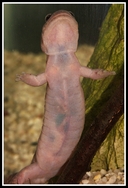|
Description
Adults reach sizes of 71-73 mm snout-vent length and 121-133 mm total length. The trunk is fairly long and stocky. The tail is broad at the base and, when viewed from above, narrows to the tip. The limbs are long and robust as well. When the fore- and hindlimbs are adpressed, the toes of each overlap by the distance of one costal grove or more. There are 13, occasionally 14, costal groves. The hind feet have five toes. The dorsal color is reddish brown with sporadic yellowish spots from head to tail. The ventral color is light and without markings. Distribution and Habitat
Country distribution from AmphibiaWeb's database: Japan
Restricted to the island of Togo in the Oki Archipelago of Shimane Prefecture. Oki salamanders inhabit all types of forest throughout Togo, from sea level to high altitudes.Life History, Abundance, Activity, and Special Behaviors
The breeding season is from the end of February to the beginning of April. In late fall many adults gather around the headwaters of mountain brooks, where they spend the winter. It is thought that they breed in underground stretches of the brooks. There is no detailed description available of whole egg sacs, but one sac of a pair or fragments are frequently found washed down in the brooks. One clutch seems to have 20-60 eggs. Larvae are profuse in the small tributaries of mountain brooks. The larvae have claws, but these are poorly developed in larvae that live in slow-moving rivulets. Some larvae metamorphose and leave the water at the end of August or beginning of September, while others spend the winter as larvae. Possible reasons for amphibian decline General habitat alteration and loss
Habitat modification from deforestation, or logging related activities
Local pesticides, fertilizers, and pollutants
Comments
This is the only salamander in its range. It was once thought to be a subspecies of Hynobius naevius but is now recognized as a full species, as it was in the original description; its coloration is completely different from that of H. naevius.
References
Goris, R.C. and Maeda, N. (2004). Guide to the Amphibians and Reptiles of Japan. Krieger Publishing Company, Malabar, Florida.
Originally submitted by: Nichole Winters (first posted 2006-09-22)
Edited by: Tate Tunstall (2006-11-21)Species Account Citation: AmphibiaWeb 2006 Hynobius okiensis: Oki Salamander <https://amphibiaweb.org/species/3892> University of California, Berkeley, CA, USA. Accessed May 29, 2025.
Feedback or comments about this page.
Citation: AmphibiaWeb. 2025. <https://amphibiaweb.org> University of California, Berkeley, CA, USA. Accessed 29 May 2025.
AmphibiaWeb's policy on data use.
|




 Raffaëlli Account
Raffaëlli Account Map of Life
Map of Life